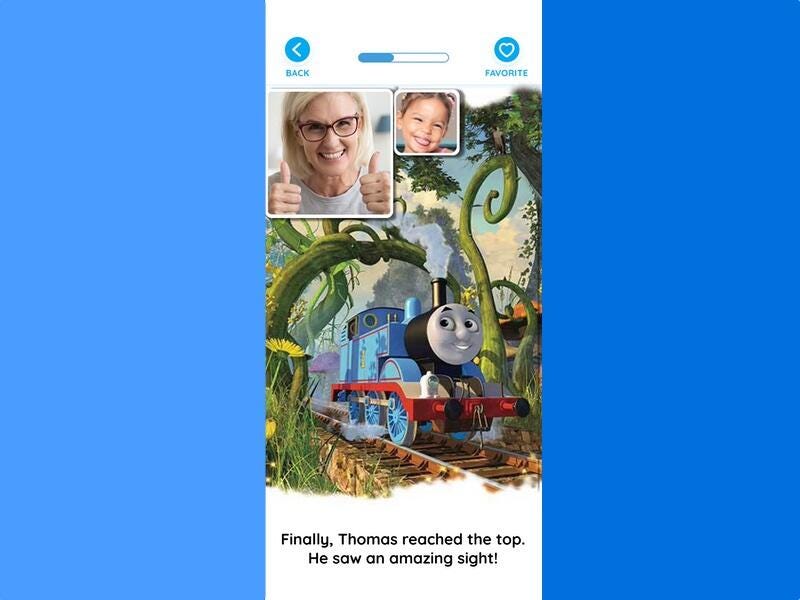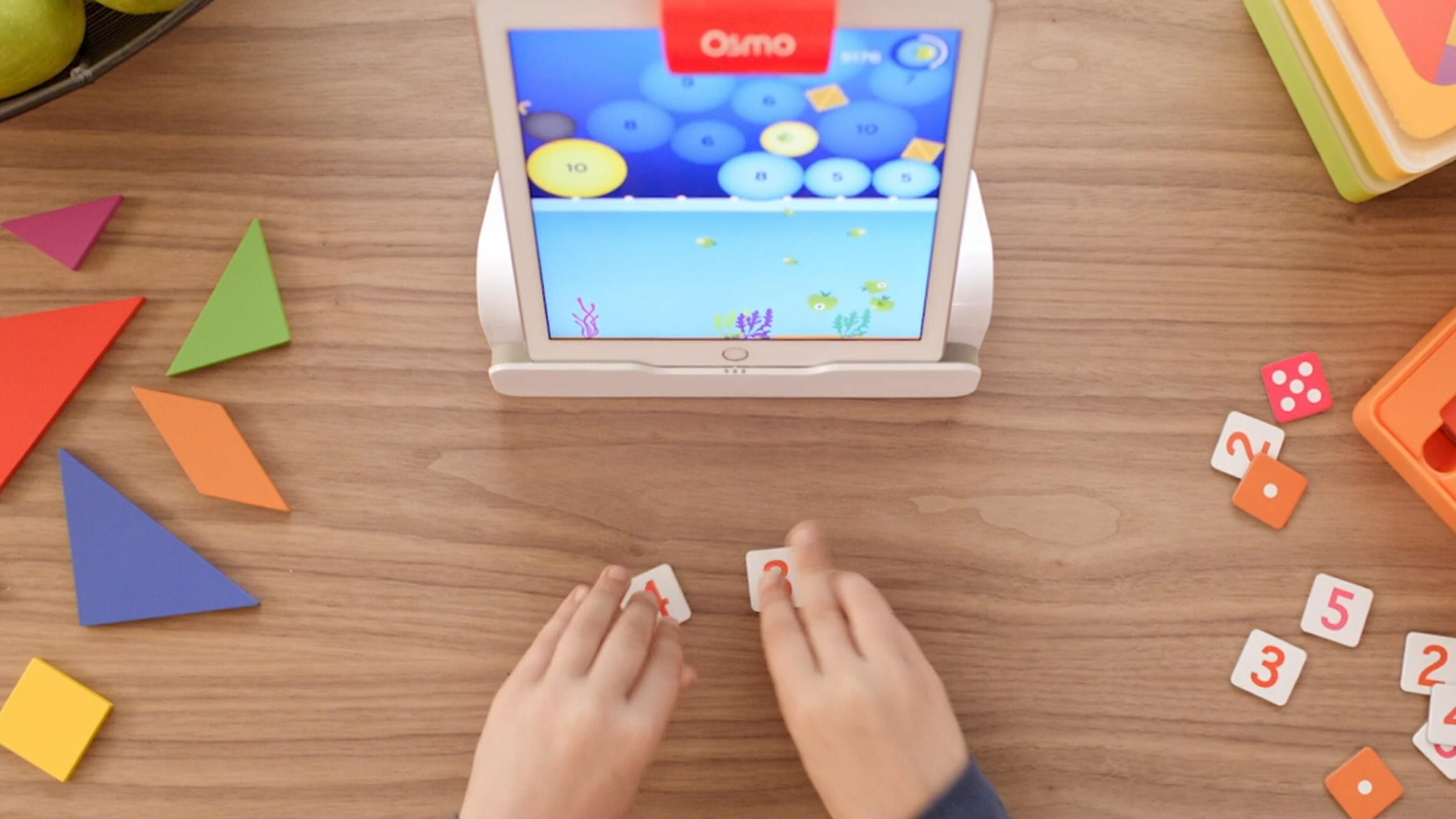
Amazon’s Glow is a new video chatting gadget that allows children to play games and participate in activities with loved ones remotely.
Amazon
Amazon announced a new device called the Glow during its fall product launch event, a $250 video chatting gadget that allows children to virtually interact with loved ones by playing games and reading books together. Although the company has been selling the Echo Dot Kids Edition for years, it’s rare for Amazon to develop an entirely new device designed specifically for children.
While it’s new for Amazon, the general concept behind Glow might sound familiar — especially if you’ve ever used the storytelling app Caribu or the Osmo brand of educational tablet accessories. That’s because although they’re different products, they share a lot of underlying qualities with Amazon’s Glow. Caribu is designed to help kids play games and read stories with relatives remotely through an interactive video chatting platform, and Osmo is all about incorporating real-world game pieces into educational games you can play on a tablet.
Read more: Amazon unwraps privacy features as it tries to roll deeper into your home
To understand the similarities, it’s important to know how the Glow works. Amazon Glow is an Alexa-free video chatting device that consists of an 8-inch upright display, a camera with a built-in shutter and a projector. The device isn’t available to the public yet and can only be obtained via invitation since it’s part of the company’s Day 1 Editions program.
The basic premise behind the Glow is simple. Children can video chat with relatives and loved ones on the device’s screen, while a projector conjures up a virtual play area for games and activities that’s displayed on a silicone mat in front of them. The person on the other end of the call can participate in that game or puzzle on their tablet through the Glow app.
The activities are also designed to combine real-world elements with digital ones. For example, in a demo video on Amazon’s website, kids can be seen arranging physical game tiles, drawing pictures with their finger on the play mat and moving digital puzzle pieces on the mat — all while a grandparent or aunt on the other end cheers them on. The device will come with a one-year subscription to Amazon Kids Plus and will feature content from Disney, Sesame Street, Barbie, Pixar and Hot Wheels.
The Caribu app is built on a similar concept, but with a different execution: It’s an app with the same goal, not a purpose-built device. Caribu is meant to make the video calling experience more interactive by enabling children and loved ones to share experiences like bedtime stories, coloring sheets and games virtually. It’s essentially like a Zoom for kids that’s available on iOS, Android and the web, but with built-in activities.
The app has been around since 2016, but grew in popularity throughout the pandemic as relatives looked for ways to connect with little ones they couldn’t see in person. Maxeme Tuchman, Caribu’s CEO and co-founder, doesn’t seem bothered by Amazon’s entry into the space.
“What I can say is that Caribu obviously identified a problem in the market, started a trend, and now everyone wants in,” Tuchman said in a statement.

You can use the Caribu app to video chat and read stories to the child in your life.
Caribu
Osmo, on the other hand, is more about turning your tablet into an interactive device for educational games and activities rather than social interaction. Osmo’s system involves slotting a compatible tablet into a base that enables it to stand upright in portrait mode. You would then place a red reflector piece over the device’s camera. This reflector enables the tablet to detect physical game pieces so that these real-world elements can be incorporated into the game on screen.
Games designed for the Osmo cover a range of skills, including coding, literacy, critical thinking, drawing, math and science. Certain Osmo bundles are priced similarly to the Amazon Glow, but the starter kit — which includes the base, reflector, and four games aimed at children ages 3 to 5 — costs just $79.
Read more: Always Home Cam: Amazon’s flying Ring drone might be tricky to get your hands on
Like Caribu, Osmo isn’t an apples-to-apples competitor to Amazon Glow. Amazon seems focused on the technology while it relies on big-name partners for most of the content, unlike Osmo. And Osmo is centered on solo playtime and learning, rather than shared experiences.
There are also some fundamental differences in how the products work. Osmo doesn’t project images onto a nearby surface like the Glow. Instead it uses the reflector to send an image of game pieces or a child’s drawing to the tablet’s camera so it can be incorporated into the game. Amazon also specifically mentions that the Glow itself isn’t a toy, despite its similarity to products that are considered to be part of the toy market.

Osmo
Still, the core appeal of both products comes down to combining an on-screen experience with real-world play elements. As is the case with Caribu, the concepts are just carried out in different ways.
Similar to Tuchman, Osmo co-creator Pramod Sharma didn’t express concern about increased competition from Amazon.
“We’re excited to see Amazon join the play movement we started with Osmo over seven years ago,” Sharma said via email.
Amazon’s device also isn’t the first experimental computing device to rely on a projector as a central part of the interaction. You might remember HP’s Sprout Windows 8 all-in-one PC from 2014, which projected a second screen onto a 20-inch touch sensitive mat situated in front of the computer for drawing and other creative work.
It’s easy to understand why Amazon would develop a product like the Glow at a time like this. The pandemic has normalized remote learning and fueled interest in connecting with family members virtually. At the same time, technology is playing a bigger role in the global market for educational toys, which is expected to grow from $19.2 billion in 2020 to $31.62 billion by 2026, according to Arziton Advisory and Intelligence. Toys that use augmented reality to overlay digital graphics on real-world objects will likely boost the demand for learning toys year-over-year, says the report.
Tech companies are also increasingly tailoring their products to appeal to younger audiences. Facebook offers a version of its Messenger chat app for children, and the company has been building a version of Instagram for kids, too. (Those plans were recently put on hold following backlash over the concerns that come with exposing younger age groups to social media.) Apple launched parental controls for the iPhone in 2019 and released Swift Playgrounds in 2016, a game aimed at teaching children how to code in Apple’s Swift programming language.
It’s too soon to know whether the Amazon Glow will be a success. Amazon’s Day 1 Editions program is meant to provide access to new products before they’re ready for prime time, meaning they may not be ready for widespread release. Not all products in the program make it past the Day 1 Editions phase either. The Echo Loop, an Alexa-powered smart ring, never graduated from Day 1 Editions to become a real product, for example.
We’ll have to wait until we’ve tried Amazon’s new child-friendly gadget to know how it stacks up against existing products.








